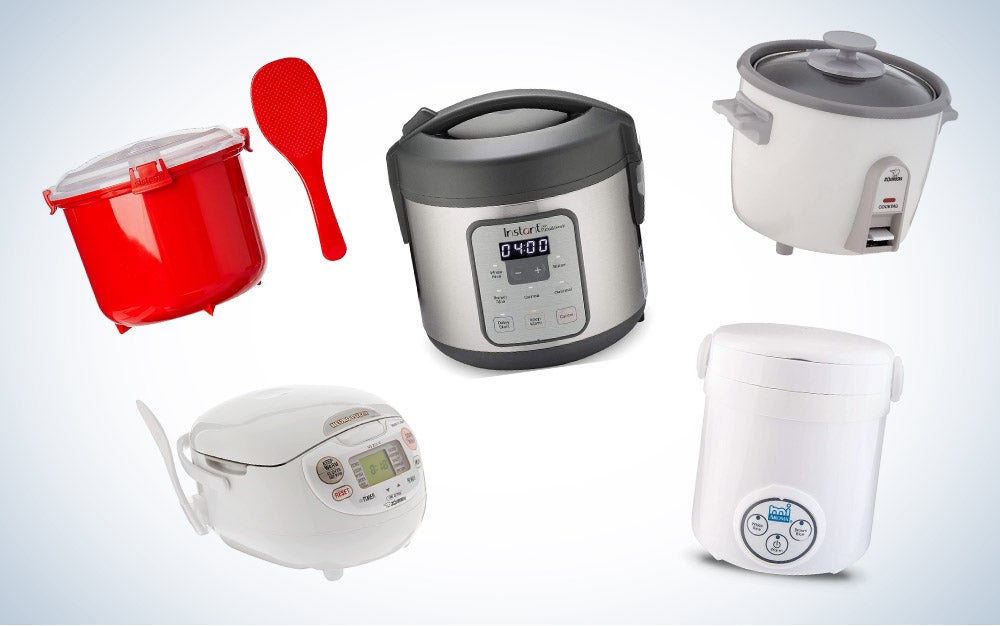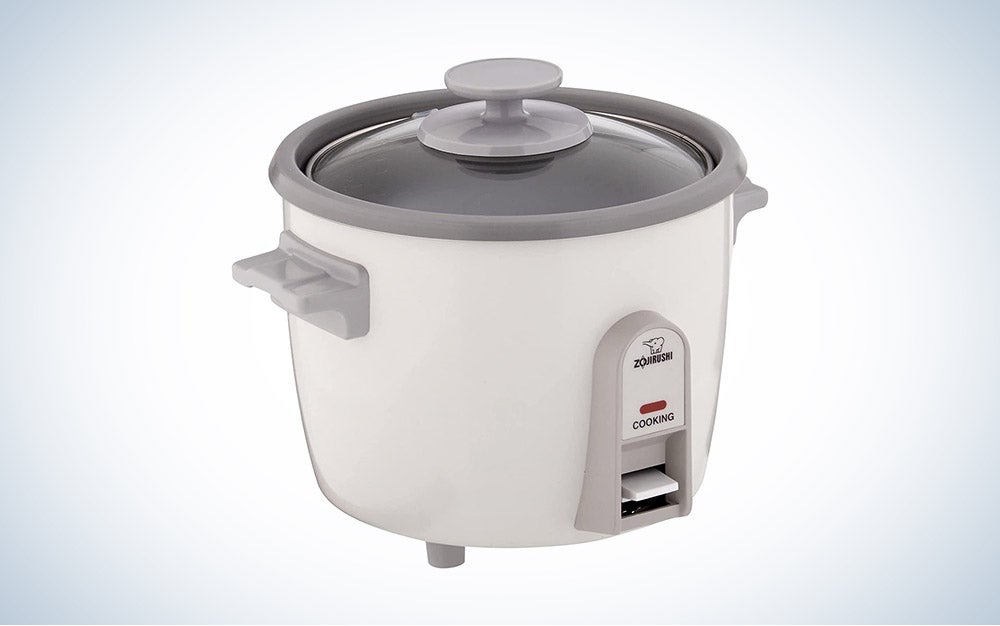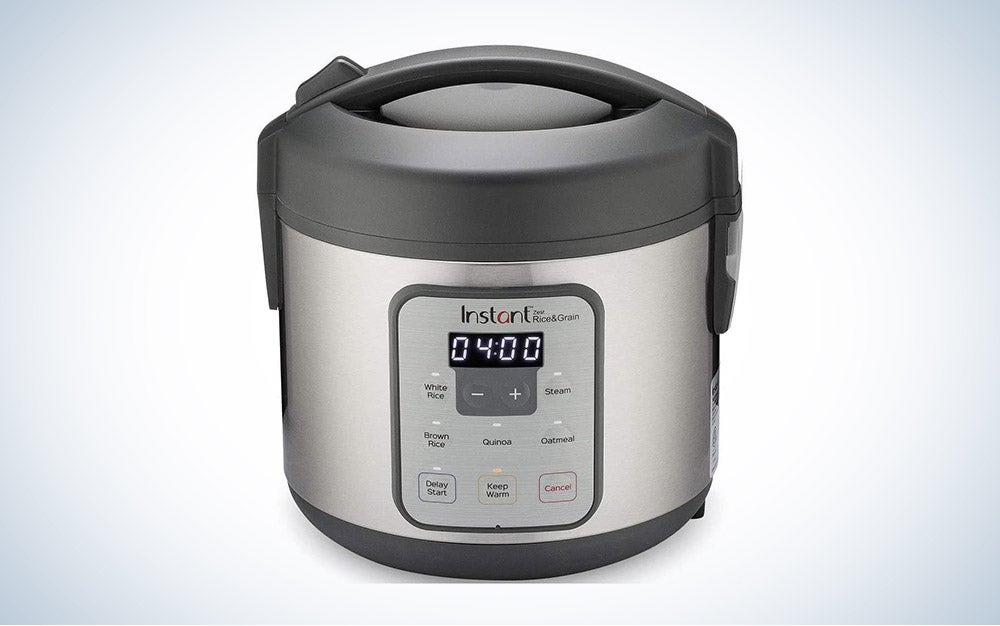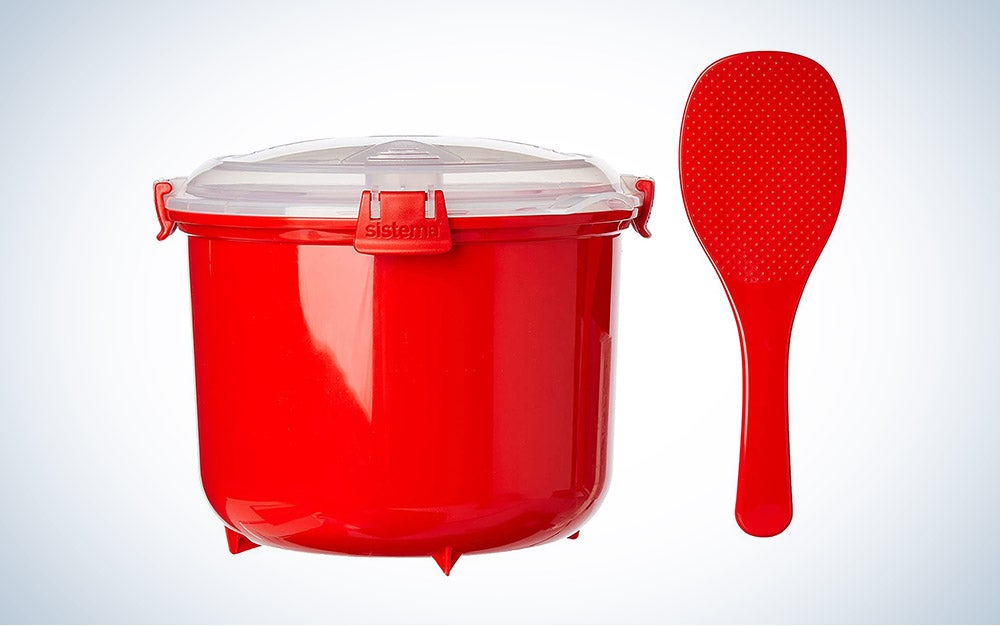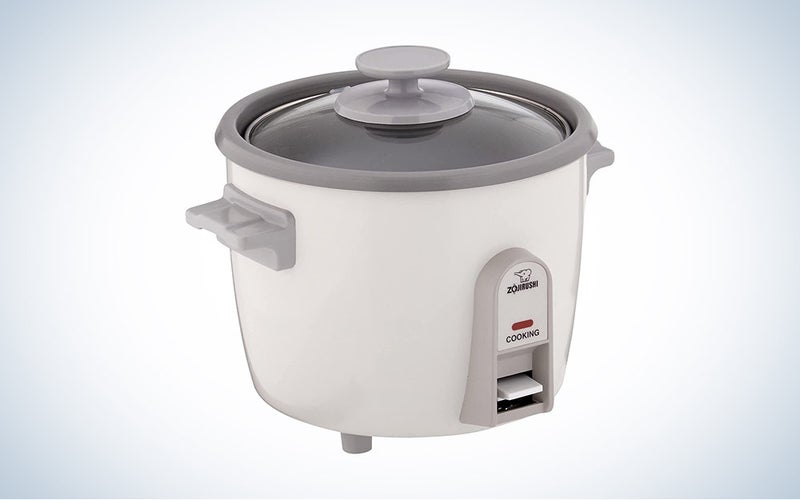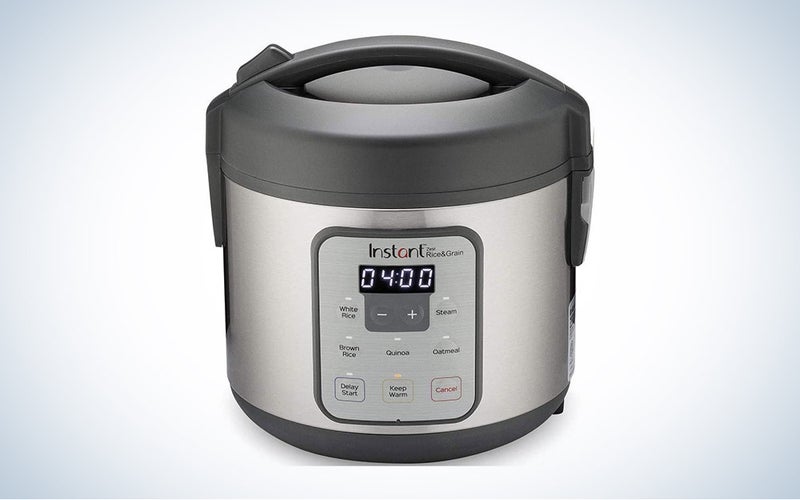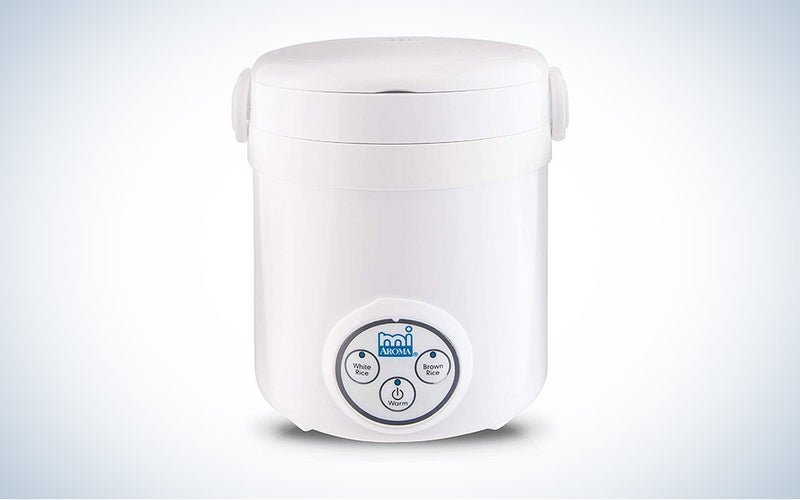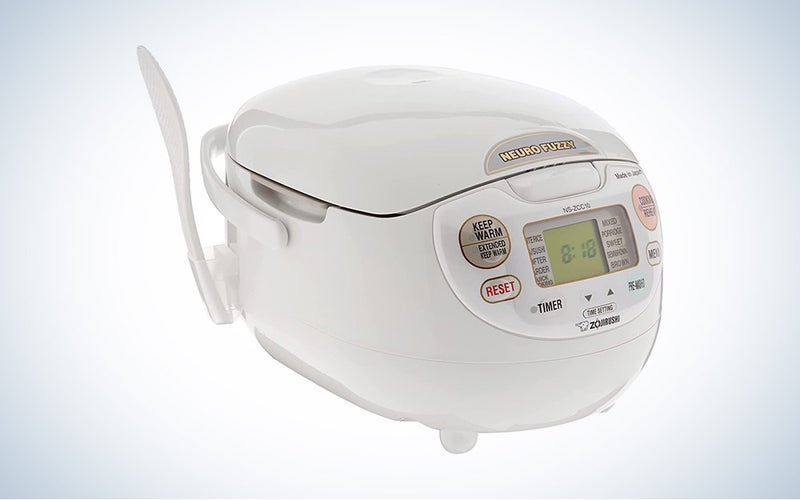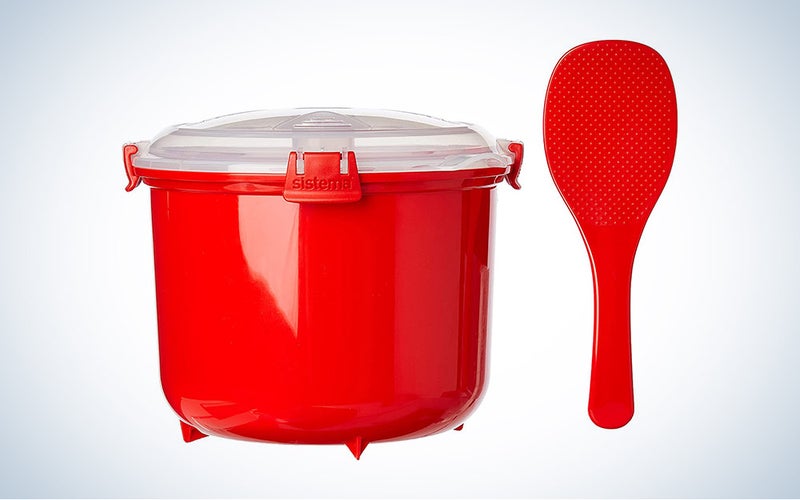We may earn revenue from the products available on this page and participate in affiliate programs. Learn more ›
Cooking rice seems simple, but it’s surprisingly easy to screw up. These machines make it quick and easy.
Rice is one of the most widely consumed grains on the planet. More than half of the world’s population eats it as their primary staple in meals spanning from breakfast to dessert. Growing it requires very specific conditions including a delicate balance of flooding and draining (kind of like cooking it). For as popular as rice is, it’s also very easy to screw up.
Whether you’ve ended up with overcooked and mushy slop or undercooked and crunchy grains, there seems to be some ineffable art—or science—to getting it just right. Whatever it is, rice cookers have cracked the code. Here are some of the best rice cookers for getting perfectly fluffy rice.
- Best overall: Zojirushi NHS-06 Rice Cooker
- Best value: Instant Pot Zest 8 Cup Rice Cooker
- Best small option: Aroma Housewares Mi 3-Cup Rice Cooker
- Best for sushi: Zojirushi Neuro Fuzzy Rice Cooker
- Best for the microwave: Sistema Microwave Collection Rice Cooker
How chose the best rice cookers
Even though rice seems very basic, there are endless ways it is served around the world. Likewise, when it comes to rice cookers, there is no one-size-fits-all formula. In fact, size is one of the distinguishing factors we considered in looking at different kinds of rice cookers for a range of cooking needs. Next, we analyzed convenience, features, and how you’re planning on using it in real life.
Since we live in an era of multifunctional appliances, we honed in on products specifically designed to do one thing especially well—cook rice. Some can be used in other ways, but their primary function is cooking rice. When it came to price, we also selected options for different lifestyles, from the serious home chef to the casual cook.
The best rice cookers: Reviews & Recommendations
Best overall: Zojirushi NHS-06 3-Cup (Uncooked) Rice Cooker
Zojirushi
Specs:
- 3, 6, and 10-cup capacity
- Electric
- Steam function
Pros:
- Good price
- One-switch convenience
- Nonstick
Cons:
- Basic design
If you’re venturing into the world of rice cookers, Zojirushi is a brand you’ll get to know quickly. While they weren’t part of Japan’s rice cooker race in the 1950s (an invention ultimately credited to Toshiba in 1955), it has since eked out a place in the niche appliance arena with its rice cookers.
The company actually got its start in 1918 with glass-lined vacuum bottles, but in 1970 it launched its first electric rice warmer and started computerizing its rice cookers in the 1980s. On the brand site, the company also breaks down some common rice cooking fails and how to fix them for anyone interested in really getting schooled on the secret to tender grains. Although you don’t really need to study up because they’ve done the work for you with top-notch rice cookers aficionados swear by.
Admittedly, the Zojirushi NHS-06 lacks some of the bells and whistles of their very swish, higher-end models, but for the price point, this one is reliable, straightforward, and easy to use. It features a simple, one-and-done single switch control and cleanup is also a breeze with a nonstick cooking pan. The included stainless steel steamer adds functionality and the glass lid allows you to keep tabs on your rice as it cooks.
It comes in three different capacities to handle three, six, or even ten cups depending on how much rice you’re planning to prepare.
Best value: Instant Pot Zest 8 Cup Rice Cooker
Instant Pot
Specs:
- 8 cup capacity
- Electric
- Steamer function
Pros:
- Affordable
- Clear interface
- Latching lid
Cons: 3-5
- Unclear instructions
- Big
As a brand, Instant (best known for its Instant Pot notoriety) has pretty much built its reputation on “set it and walk away” convenience. While this rice cooker is not a pressure cooker, it does offer four smart programs for one-touch cooking of white rice, brown rice, quinoa, and oatmeal (you can experiment with other trendy grains like farro and couscous, but we can only vouch for its rice-cooking abilities).
The nonstick ceramic-coated pot does a good job of producing uniformly cooked rice and is dishwater safe for a quick cleanup. It also has built-in safety features to prevent overheating and an auto-off function, Similar to its Instant cousins, you can walk away and get sucked into writing a long work email without burning dinner (it also beeps to alert you when it’s done). You can also use it to steam food and keep food warm.
The non-stick ceramic-coated pot is simple to clean, and the included stainless steel steamer basket allows for cooking vegetables as well as rice.
Best small option: Aroma Housewares (MRC-903D) Mi 3-Cup (Cooked) Rice Cooker
Aroma Housewares
Specs:
- 2-3-cup capacity
- Electric
- Removable cooking pot
Pros:
- Compact size
- Easy to use
- Reduces food waste
Cons:
- Can overflow
- Small servings
Another brand with some clout among rice cookers is Aroma. Their full-size rice models provide consistent results, which they’ve scaled down for this mini appliance designed for solo diners and couples. It can accommodate up to a cup and a half of uncooked rice which fluffs up to about three cups max.
If you’ve got a tiny kitchen, live on your own, or eat enough rice to require a travel-size option, this tiny machine has a collapsible carry handle and plenty of culinary moxie with easy-to-use controls and auto “keep warm” functions. You also get a pretty adorable mini spatula and rice measuring cup in the box.
It stands just over seven inches tall and its footprint measures less than seven inches in very direction. That makes it compact enough to easily store or even keep out on your counter all the time if you don’t have the cabinet space.
Beyond rice, you can use it to heat up soup, whip up an omelet, and even bake little cakes (among other life hacks gleaned from the internet). It is small, but if you don’t like wasting food, it’s perfectly portioned.
Best for sushi: Zojirushi Neuro Fuzzy Rice Cooker
Zojirushi
Specs:
- 5.5-cup and 10-cup options
- Electric
- Spherical non-stick cooking pot
Pros:
- Smart tech
- Versatile uses
- Rugged construction
Cons:
- Expensive
- Drab design
If you’re looking for a snazzy, top-of-the-line rice cooker this one has a microchip and neuro-fuzzy, AI technology to adjust cook times and temperatures for the type of rice you’re making. The accompanying price tag does match these premium, smart features, but for serious rice connoisseurs, it’s worth the extra dosh for flawless grains every time.
Like most rice cookers, it comes with a few accessories, including a spatula, spatula holder, and two measuring cups (since this is a cut above you get a regular and rinse-free one). It has a large, easy-to-read LCD display, and programmable ringtones and beeps (if you have other Japanese appliances which sing to you when they’re done, you’ll recognize the melodies). The menu settings encompass specific uses, such as sushi, as well as texture preferences, such as firm or soft.
It also has an extended-play version of its auto keep warm function and a reheating cycle. You can also use a programmable delay timer. All in all, this sweeps the categories.
Best for the microwave: Sistema Microwave Collection Rice Cooker
Sistema
Specs:
- 2.6-liter capacity
- Non-electric
- Dishwasher safe
Pros:
- Microwave-friendly
- Quick preparation
- Entirely dishwasher safe
Cons:
- Time consuming
- Plastic construction
Made for the microwave specifically, this rice cooker is a surprisingly handy tool. It has won praise from those who have been burned in the past by stovetop preparation or shoddily made electric cookers and offers a somewhat ingenious alternative. It does cost as much as some lower-end electric rice cookers, but is less of a gamble.
You can use it at home or at work, although it does take around 15 minutes or longer to prepare rice, so you’ll want to be mindful of the lunchtime rush when using a communal microwave. Along with rice, you can also cook polenta and couscous.
To avoid a hot mess, the design features a pressure chamber plate to capture any overflow and drain it back into the base chamber. However, it is important to follow the directions carefully because going rogue can produce some really disastrous results.
Other features worth noting are the cool-to-touch lid, easy-lift tabs, and nonstick rice spoon. When you’re done, run the entire system through the dishwasher on the top rack.
Things to consider when buying a rice cooker
Capacity
Rice cookers often give their output in cooked or uncooked cups of rice. To find the right size, double-check the amount of cooked rice you’ll get so you don’t end up with a model that is too big or too small. Most rice cookers come in around three or six cups in capacity, but some larger models go up to 10. That’s probably overkill for most people.
Features
Models can run the gamut from a single setting to a full-color LCD display, which can also push up the price point. Depending on how exacting you want to be about cooking rice, you may be fine with a few buttons or settings. Some people prefer very few features—push a button and chill out until your rice is done.
Accessories
Most rice cookers will come with a basic measuring cup and spatula. Really high-end ones may have a few extra perks in the box. Although these add-ons are a nice touch and convenient to have on hand (especially the spatula), in real-world use, they’re not a deal-maker or breaker.
FAQs
Q: What should I look for when buying a rice cooker?
Everybody is different, but in general, you want to look for a capacity that suits your needs (so, if you have a family of 10, not the two-cup cooker), fuzzy logic (for a self-adjusting intuitive cook), keep-warm and delay functions if you don’t plan to serve right away, and a quick-cook function if time is of the essence.
Q: Can you not cook rice in stainless steel?
You can! In fact, some of the best rice cookers are made of stainless steel. Unlike Teflon-coated aluminum, which is non-stick, stainless steel won’t release chemicals when scratched, so stainless can actually be a better pick than Teflon for a rice cooker. (When you scrape bits of rice off the bottom of a Teflon model, you have to be careful not to scratch the surface.) In addition to stainless steel, other worry-free materials for cookers include ceramic and clay.
A final word about the best rice cookers
Cooking rice on the stovetop can make you feel like a dunce in the kitchen. A rice cooker can set you up for culinary success with a wide range of options for your lifestyle. The best rice cookers are easy to use and scale up from basic, one-setting models all the way up to next-gen, AI-enabled models that do the thinking for you.
They’re game-changers for your cooking repertoire, especially if you’ve ever been left with grains glued to the bottom of your favorite pot. However, there are also some tricks for getting the best results with a rice cooker, such as rinsing away surface starch for nicely separated grains instead of a congealed glob. Of course, for some rice dishes, you do actually want some stickiness.
Following the instructions and not overfilling your rice cooker is another way to prolong its use and avoid cooking fails and product faults.
Why trust us
Popular Science started writing about technology more than 150 years ago. There was no such thing as “gadget writing” when we published our first issue in 1872, but if there was, our mission to demystify the world of innovation for everyday readers means we would have been all over it. Here in the present, PopSci is fully committed to helping readers navigate the increasingly intimidating array of devices on the market right now.
Our writers and editors have combined decades of experience covering and reviewing consumer electronics. We each have our own obsessive specialties—from high-end audio to video games to cameras and beyond—but when we’re reviewing devices outside of our immediate wheelhouses, we do our best to seek out trustworthy voices and opinions to help guide people to the very best recommendations. We know we don’t know everything, but we’re excited to live through the analysis paralysis that internet shopping can spur so readers don’t have to.
